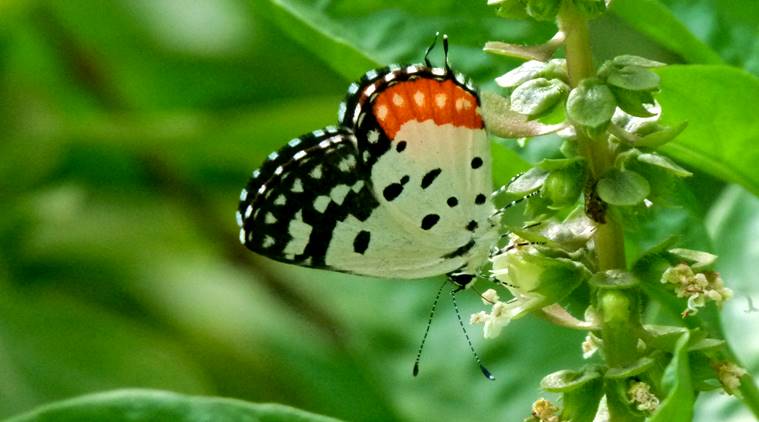Down in Jungleland: The Red Pierrot Mystery
If only humans, too, could metamorphose like the butterfly.
 Described as a “weak flyer”, it seemed sprightly and full of vim.
Described as a “weak flyer”, it seemed sprightly and full of vim.
It appeared suddenly one morning in the middle of May, out of the blue — a pretty little butterfly, polka-dotted in black and white, with an attractive scarlet splash on its hind wings. It had dark expressive eyes. I knew it was the red Pierrot, it had appeared in the garden before, a year or two ago. A rarity in Delhi, it’s apparently getting more common as its food plant, a species of Kalanchoe and Bryophyllum, has become popular as potted flowering plants, and this little butterfly never strays far from them. I tried checking what these plants looked like (they have succulent leaves and are found in a huge variety) but couldn’t find anything remotely similar in my garden. The little butterfly was flying up and down the chilli and spinach bed, hardly pausing to rest. Though described as a “weak flyer”, it seemed sprightly and full of vim and I had a hard time tracking its movements.
Where, I wondered, had this little butterfly suddenly turned up from? Sometimes the eggs remain dormant in winter and hatch out in spring. Had this one, too, recently emerged? From where? Found mostly all over the country, they apparently like arid regions — and there can be nothing more arid than Delhi in mid-summer. The following morning the mystery intensified.
The little butterfly was joined by a partner. Together, they chased each other up and down the same bed of chillies until, hey presto, they discovered the English basil growing thickly in a bed a stone’s throw away. The racing and chasing was interspersed with long pit stops for refueling on the basil-flower nectar. In the garden that has more vegetables than flowers, this was their favourite bar. I was hoping to get an intimate click, but alas, I wasn’t lucky. Below the basil, ajwain (carom seeds) was growing with its thick and succulent leaves, but so far there’s been no sign of a happy (butterfly) event there.
When the eggs, laid on the food plant, hatch, the caterpillar burrows itself inside the leaves (like an infestation). It’s not a particularly prepossessing creature — a yellowish grub with black spots and spindly hairs. Safe within the leaf, it gets back on the leaf and wriggles out its cocoon when it’s ready to hatch.
Then, after, what I can only assume, was a three-day honeymoon, the couple just vanished. Perhaps, they had used the garden only for honeymooning and its bar services — perhaps, their food plant was growing in neighbouring gardens where they could start their families. I’m still examining the leaves of the plants they hovered around but haven’t found any sign of eggs or caterpillars. I wonder where they have gone, if they are alive. And hope that next summer, the mystery will manifest itself again.
The red Pierrot belongs to the clan of Lycaenidae, or the blues, which are the small blue, lilac and purple butterflies you disturb while walking through grass.
Eggs, like little pearls, hatch out on the food plant and these little bingeing machines emerge. They could be dressed like bird droppings or covered with spines or fine hair, which will make you scratch like a monkey if you touch them, or they are as gaudily coloured as a scary clown, warning all comers to maintain distance. Some will even rear up cobra style and flick out what looks like a forked tongue at you if you disturb them. And all they do through their gluttonous existence is eat. You might feel nauseous watching their little jaws saw relentlessly up and down the sides of a leaf as they demolish it. It’s like a hamburger-eating contest gone viral. Naturally they grow — and how — into barrage balloons.
Then, struck by their conscience, they stop eating, and do penance by spinning themselves a silken cocoon and performing the caterpillar-equivalent of meditation and yoga. It pays off, because within a week or so, they metamorphose. The gross, obese creature now emerges, timorously, a delicate and beautiful flying machine, with a watch-spring proboscis and big dark eyes. From now on, it will only sip tiny amounts of nectar (and umm…maybe a lot of fermenting fruit juice, rum and dung!) and gladden your heart as it flits and flirts in your garden.
But to let you into a devilish little secret: even as a pupa, the binging hasn’t stopped. What happens is that the cells that formed the gross caterpillar break down into a “soup” and the butterfly cells — lying dormant so far — suddenly get booted up and take their nourishment from this soup, while building the various parts of the butterfly.
But it makes you wonder: how is it possible that from something so gross and greedy, something so ethereal and delicate can emerge? If only, that could be true for our own species…
Photos


- 01
- 02
- 03
- 04
- 05





























